CHEVROLET UPLANDER 2005 1.G Repair Manual
Manufacturer: CHEVROLET, Model Year: 2005, Model line: UPLANDER, Model: CHEVROLET UPLANDER 2005 1.GPages: 460, PDF Size: 2.75 MB
Page 61 of 460
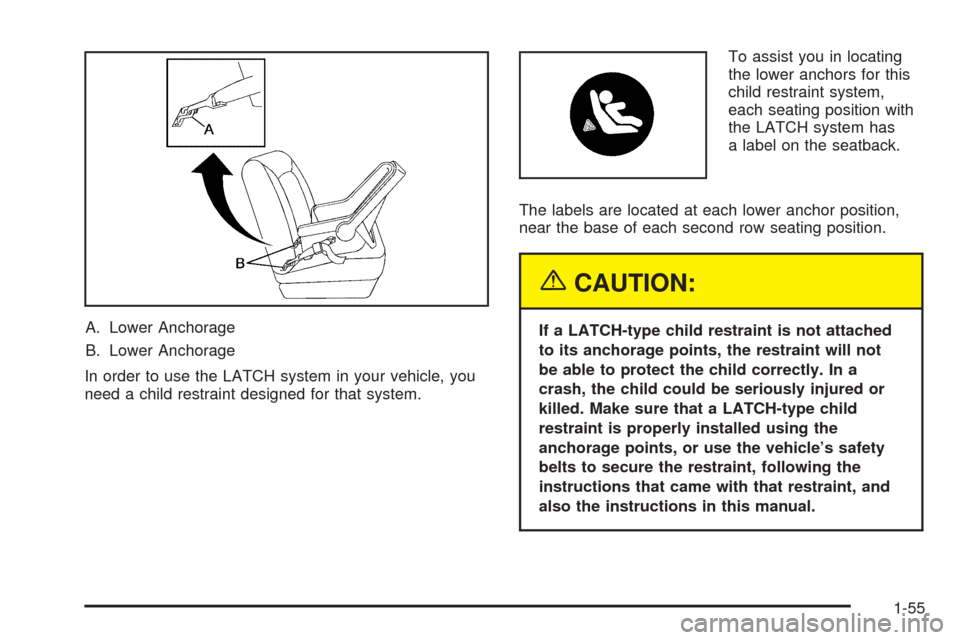
A. Lower Anchorage
B. Lower Anchorage
In order to use the LATCH system in your vehicle, you
need a child restraint designed for that system.To assist you in locating
the lower anchors for this
child restraint system,
each seating position with
the LATCH system has
a label on the seatback.
The labels are located at each lower anchor position,
near the base of each second row seating position.
{CAUTION:
If a LATCH-type child restraint is not attached
to its anchorage points, the restraint will not
be able to protect the child correctly. In a
crash, the child could be seriously injured or
killed. Make sure that a LATCH-type child
restraint is properly installed using the
anchorage points, or use the vehicle’s safety
belts to secure the restraint, following the
instructions that came with that restraint, and
also the instructions in this manual.
1-55
Page 62 of 460
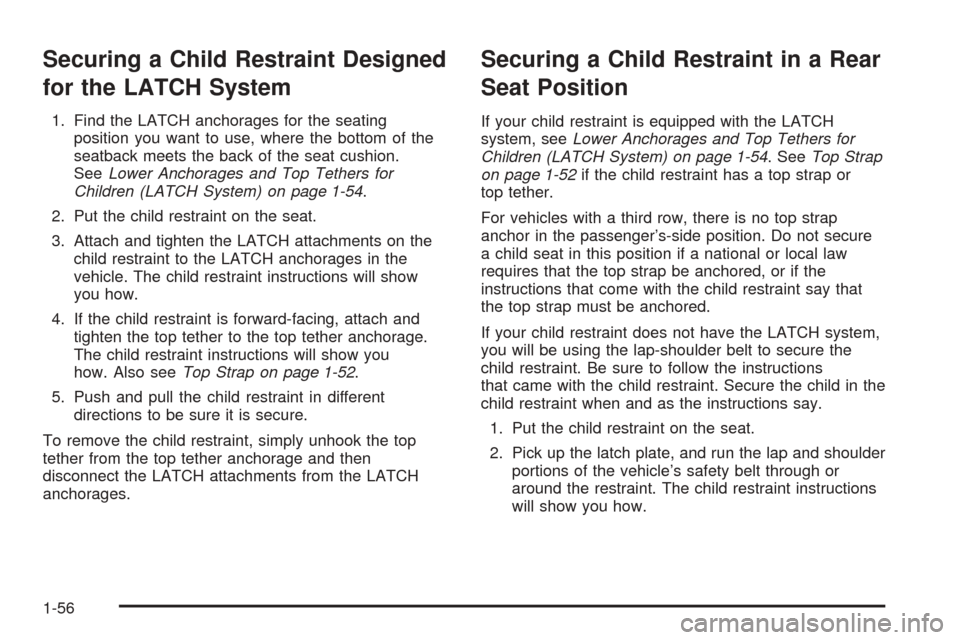
Securing a Child Restraint Designed
for the LATCH System
1. Find the LATCH anchorages for the seating
position you want to use, where the bottom of the
seatback meets the back of the seat cushion.
SeeLower Anchorages and Top Tethers for
Children (LATCH System) on page 1-54.
2. Put the child restraint on the seat.
3. Attach and tighten the LATCH attachments on the
child restraint to the LATCH anchorages in the
vehicle. The child restraint instructions will show
you how.
4. If the child restraint is forward-facing, attach and
tighten the top tether to the top tether anchorage.
The child restraint instructions will show you
how. Also seeTop Strap on page 1-52.
5. Push and pull the child restraint in different
directions to be sure it is secure.
To remove the child restraint, simply unhook the top
tether from the top tether anchorage and then
disconnect the LATCH attachments from the LATCH
anchorages.
Securing a Child Restraint in a Rear
Seat Position
If your child restraint is equipped with the LATCH
system, seeLower Anchorages and Top Tethers for
Children (LATCH System) on page 1-54. SeeTop Strap
on page 1-52if the child restraint has a top strap or
top tether.
For vehicles with a third row, there is no top strap
anchor in the passenger’s-side position. Do not secure
a child seat in this position if a national or local law
requires that the top strap be anchored, or if the
instructions that come with the child restraint say that
the top strap must be anchored.
If your child restraint does not have the LATCH system,
you will be using the lap-shoulder belt to secure the
child restraint. Be sure to follow the instructions
that came with the child restraint. Secure the child in the
child restraint when and as the instructions say.
1. Put the child restraint on the seat.
2. Pick up the latch plate, and run the lap and shoulder
portions of the vehicle’s safety belt through or
around the restraint. The child restraint instructions
will show you how.
1-56
Page 63 of 460
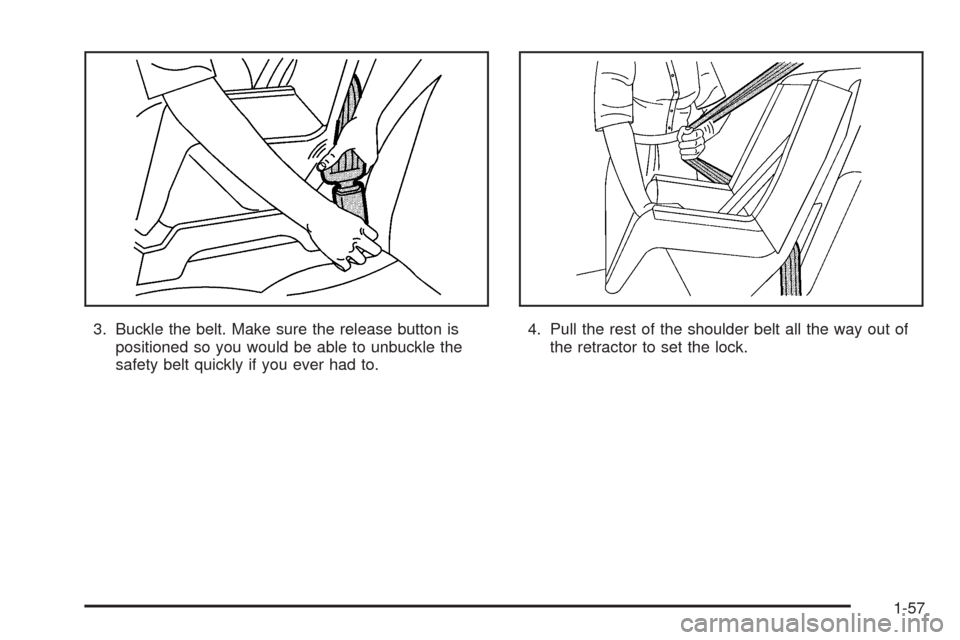
3. Buckle the belt. Make sure the release button is
positioned so you would be able to unbuckle the
safety belt quickly if you ever had to.4. Pull the rest of the shoulder belt all the way out of
the retractor to set the lock.
1-57
Page 64 of 460
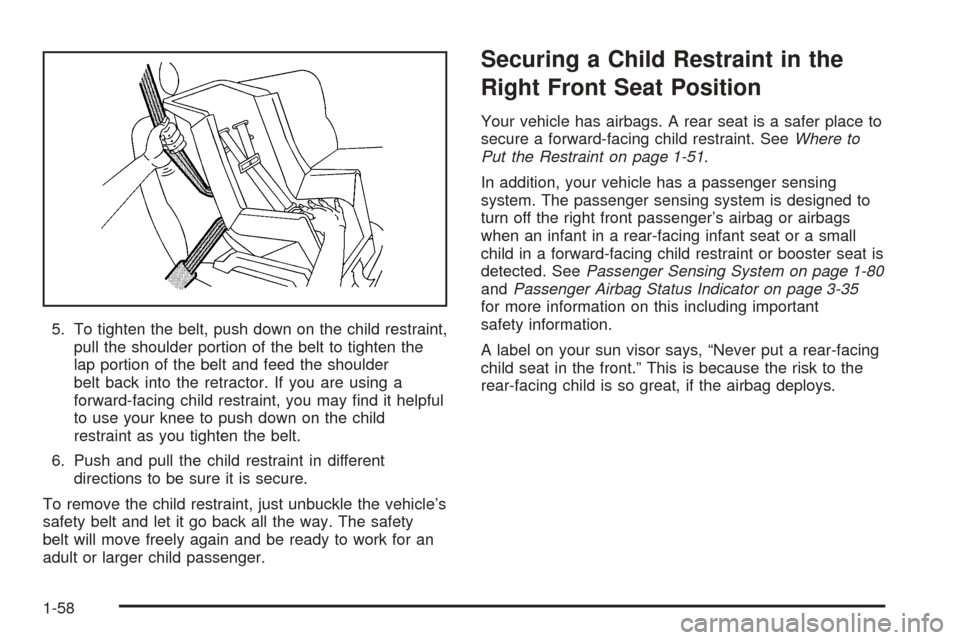
5. To tighten the belt, push down on the child restraint,
pull the shoulder portion of the belt to tighten the
lap portion of the belt and feed the shoulder
belt back into the retractor. If you are using a
forward-facing child restraint, you may �nd it helpful
to use your knee to push down on the child
restraint as you tighten the belt.
6. Push and pull the child restraint in different
directions to be sure it is secure.
To remove the child restraint, just unbuckle the vehicle’s
safety belt and let it go back all the way. The safety
belt will move freely again and be ready to work for an
adult or larger child passenger.
Securing a Child Restraint in the
Right Front Seat Position
Your vehicle has airbags. A rear seat is a safer place to
secure a forward-facing child restraint. SeeWhere to
Put the Restraint on page 1-51.
In addition, your vehicle has a passenger sensing
system. The passenger sensing system is designed to
turn off the right front passenger’s airbag or airbags
when an infant in a rear-facing infant seat or a small
child in a forward-facing child restraint or booster seat is
detected. SeePassenger Sensing System on page 1-80
andPassenger Airbag Status Indicator on page 3-35
for more information on this including important
safety information.
A label on your sun visor says, “Never put a rear-facing
child seat in the front.” This is because the risk to the
rear-facing child is so great, if the airbag deploys.
1-58
Page 65 of 460
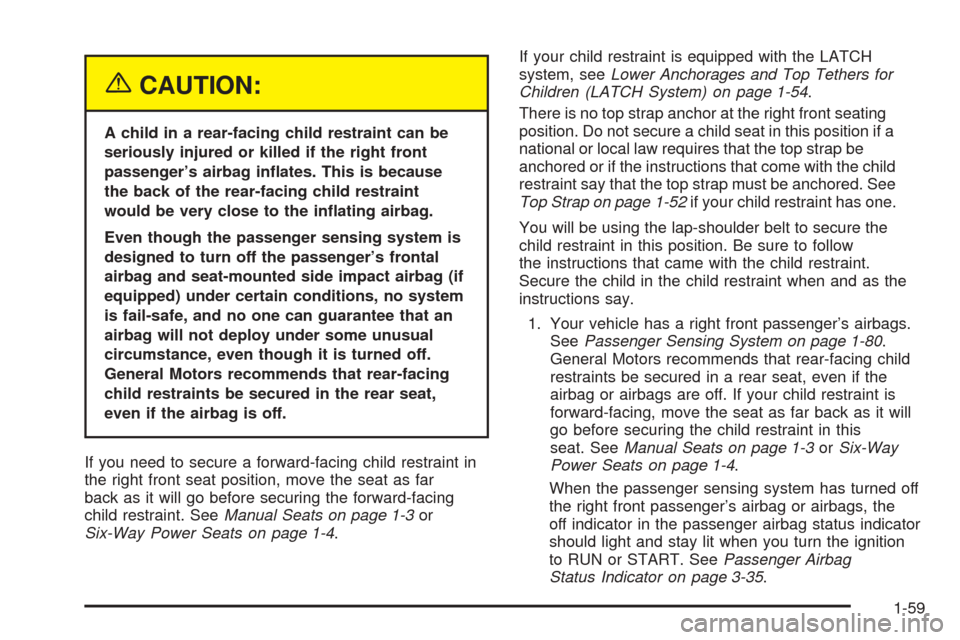
{CAUTION:
A child in a rear-facing child restraint can be
seriously injured or killed if the right front
passenger’s airbag in�ates. This is because
the back of the rear-facing child restraint
would be very close to the in�ating airbag.
Even though the passenger sensing system is
designed to turn off the passenger’s frontal
airbag and seat-mounted side impact airbag (if
equipped) under certain conditions, no system
is fail-safe, and no one can guarantee that an
airbag will not deploy under some unusual
circumstance, even though it is turned off.
General Motors recommends that rear-facing
child restraints be secured in the rear seat,
even if the airbag is off.
If you need to secure a forward-facing child restraint in
the right front seat position, move the seat as far
back as it will go before securing the forward-facing
child restraint. SeeManual Seats on page 1-3or
Six-Way Power Seats on page 1-4.If your child restraint is equipped with the LATCH
system, seeLower Anchorages and Top Tethers for
Children (LATCH System) on page 1-54.
There is no top strap anchor at the right front seating
position. Do not secure a child seat in this position if a
national or local law requires that the top strap be
anchored or if the instructions that come with the child
restraint say that the top strap must be anchored. See
Top Strap on page 1-52if your child restraint has one.
You will be using the lap-shoulder belt to secure the
child restraint in this position. Be sure to follow
the instructions that came with the child restraint.
Secure the child in the child restraint when and as the
instructions say.
1. Your vehicle has a right front passenger’s airbags.
SeePassenger Sensing System on page 1-80.
General Motors recommends that rear-facing child
restraints be secured in a rear seat, even if the
airbag or airbags are off. If your child restraint is
forward-facing, move the seat as far back as it will
go before securing the child restraint in this
seat. SeeManual Seats on page 1-3orSix-Way
Power Seats on page 1-4.
When the passenger sensing system has turned off
the right front passenger’s airbag or airbags, the
off indicator in the passenger airbag status indicator
should light and stay lit when you turn the ignition
to RUN or START. SeePassenger Airbag
Status Indicator on page 3-35.
1-59
Page 66 of 460
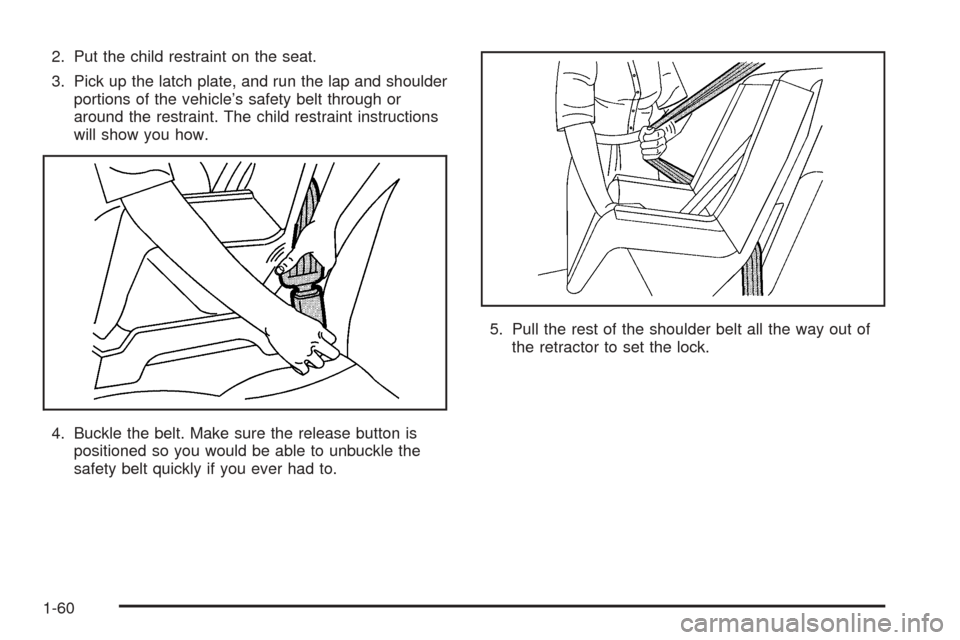
2. Put the child restraint on the seat.
3. Pick up the latch plate, and run the lap and shoulder
portions of the vehicle’s safety belt through or
around the restraint. The child restraint instructions
will show you how.
4. Buckle the belt. Make sure the release button is
positioned so you would be able to unbuckle the
safety belt quickly if you ever had to.5. Pull the rest of the shoulder belt all the way out of
the retractor to set the lock.
1-60
Page 67 of 460
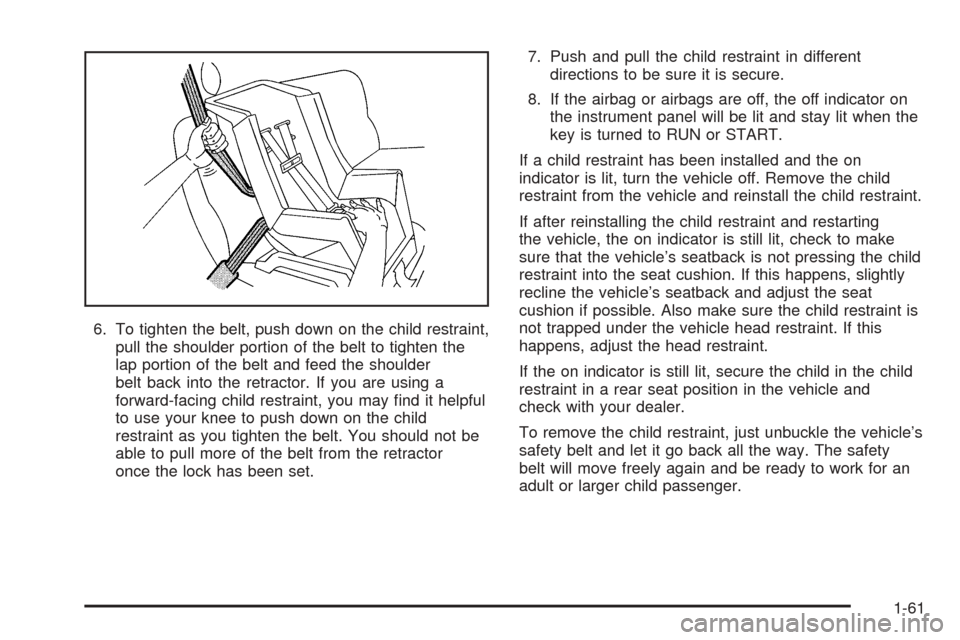
6. To tighten the belt, push down on the child restraint,
pull the shoulder portion of the belt to tighten the
lap portion of the belt and feed the shoulder
belt back into the retractor. If you are using a
forward-facing child restraint, you may �nd it helpful
to use your knee to push down on the child
restraint as you tighten the belt. You should not be
able to pull more of the belt from the retractor
once the lock has been set.7. Push and pull the child restraint in different
directions to be sure it is secure.
8. If the airbag or airbags are off, the off indicator on
the instrument panel will be lit and stay lit when the
key is turned to RUN or START.
If a child restraint has been installed and the on
indicator is lit, turn the vehicle off. Remove the child
restraint from the vehicle and reinstall the child restraint.
If after reinstalling the child restraint and restarting
the vehicle, the on indicator is still lit, check to make
sure that the vehicle’s seatback is not pressing the child
restraint into the seat cushion. If this happens, slightly
recline the vehicle’s seatback and adjust the seat
cushion if possible. Also make sure the child restraint is
not trapped under the vehicle head restraint. If this
happens, adjust the head restraint.
If the on indicator is still lit, secure the child in the child
restraint in a rear seat position in the vehicle and
check with your dealer.
To remove the child restraint, just unbuckle the vehicle’s
safety belt and let it go back all the way. The safety
belt will move freely again and be ready to work for an
adult or larger child passenger.
1-61
Page 68 of 460
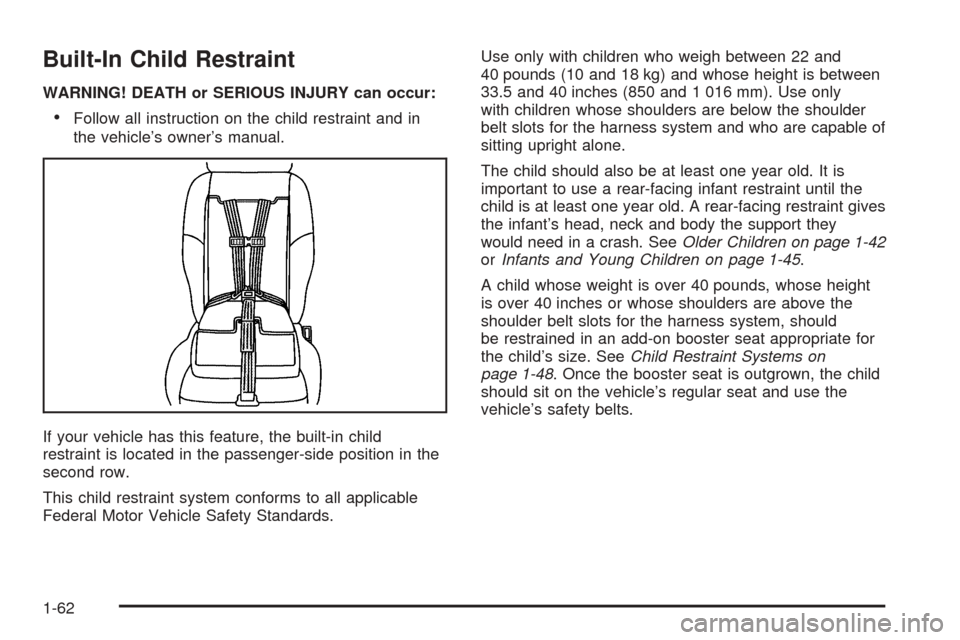
Built-In Child Restraint
WARNING! DEATH or SERIOUS INJURY can occur:
Follow all instruction on the child restraint and in
the vehicle’s owner’s manual.
If your vehicle has this feature, the built-in child
restraint is located in the passenger-side position in the
second row.
This child restraint system conforms to all applicable
Federal Motor Vehicle Safety Standards.Use only with children who weigh between 22 and
40 pounds (10 and 18 kg) and whose height is between
33.5 and 40 inches (850 and 1 016 mm). Use only
with children whose shoulders are below the shoulder
belt slots for the harness system and who are capable of
sitting upright alone.
The child should also be at least one year old. It is
important to use a rear-facing infant restraint until the
child is at least one year old. A rear-facing restraint gives
the infant’s head, neck and body the support they
would need in a crash. SeeOlder Children on page 1-42
orInfants and Young Children on page 1-45.
A child whose weight is over 40 pounds, whose height
is over 40 inches or whose shoulders are above the
shoulder belt slots for the harness system, should
be restrained in an add-on booster seat appropriate for
the child’s size. SeeChild Restraint Systems on
page 1-48. Once the booster seat is outgrown, the child
should sit on the vehicle’s regular seat and use the
vehicle’s safety belts.
1-62
Page 69 of 460
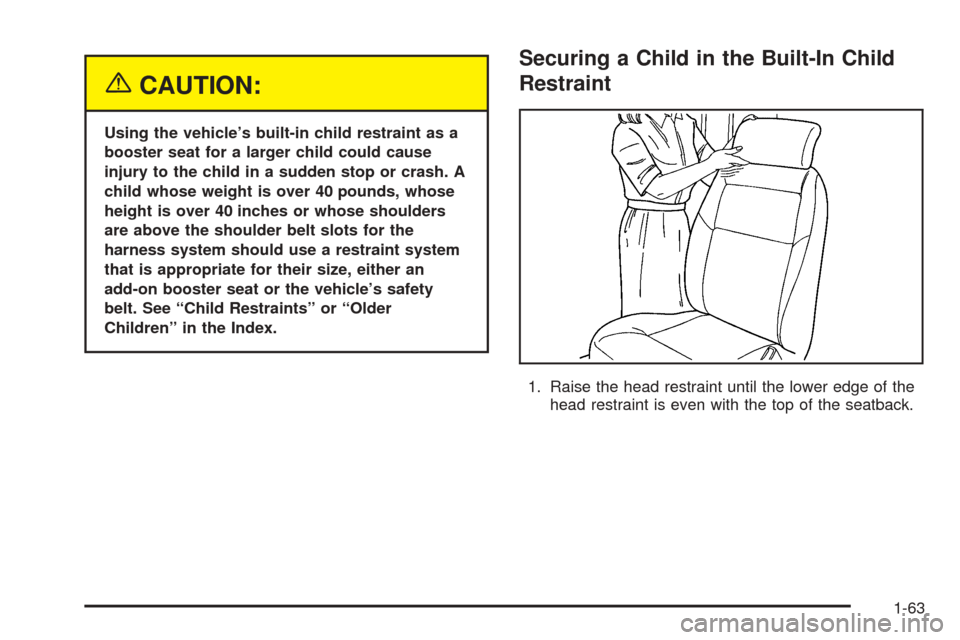
{CAUTION:
Using the vehicle’s built-in child restraint as a
booster seat for a larger child could cause
injury to the child in a sudden stop or crash. A
child whose weight is over 40 pounds, whose
height is over 40 inches or whose shoulders
are above the shoulder belt slots for the
harness system should use a restraint system
that is appropriate for their size, either an
add-on booster seat or the vehicle’s safety
belt. See “Child Restraints” or “Older
Children” in the Index.
Securing a Child in the Built-In Child
Restraint
1. Raise the head restraint until the lower edge of the
head restraint is even with the top of the seatback.
1-63
Page 70 of 460
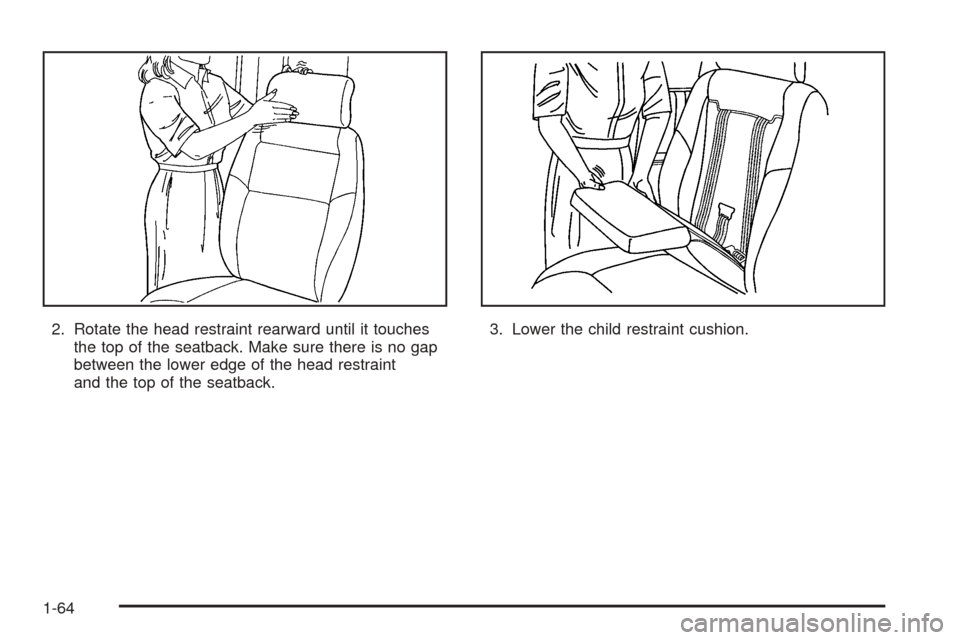
2. Rotate the head restraint rearward until it touches
the top of the seatback. Make sure there is no gap
between the lower edge of the head restraint
and the top of the seatback.3. Lower the child restraint cushion.
1-64